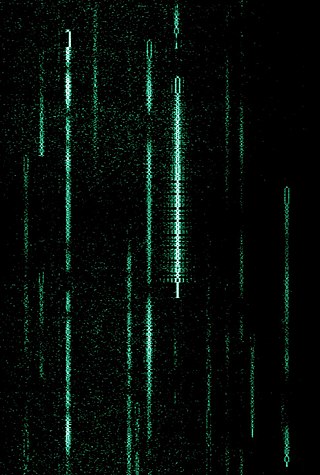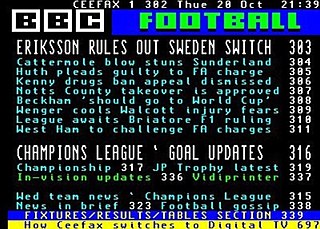
ASCII, abbreviated from American Standard Code for Information Interchange, is a character encoding standard for electronic communication. ASCII codes represent text in computers, telecommunications equipment, and other devices. Because of technical limitations of computer systems at the time it was invented, ASCII has just 128 code points, of which only 95 are printable characters, which severely limited its scope. All modern computer systems instead use Unicode, which has millions of code points, but the first 128 of these are the same as the ASCII set.

The Baudot code[boˈdo] is an early character encoding for telegraphy invented by Émile Baudot in the 1870s. It was the predecessor to the International Telegraph Alphabet No. 2 (ITA2), the most common teleprinter code in use until the advent of ASCII. Each character in the alphabet is represented by a series of five bits, sent over a communication channel such as a telegraph wire or a radio signal by asynchronous serial communication. The symbol rate measurement is known as baud, and is derived from the same name.

Character encoding is the process of assigning numbers to graphical characters, especially the written characters of human language, allowing them to be stored, transmitted, and transformed using digital computers. The numerical values that make up a character encoding are known as "code points" and collectively comprise a "code space", a "code page", or a "character map".
In computing and telecommunication, a control character or non-printing character (NPC) is a code point in a character set, that does not represent a written symbol. They are used as in-band signaling to cause effects other than the addition of a symbol to the text. All other characters are mainly printing, printable, or graphic characters, except perhaps for the "space" character.

In digital radio, packet radio is the application of packet switching techniques to digital radio communications. Packet radio uses a packet switching protocol as opposed to circuit switching or message switching protocols to transmit digital data via a radio communication link. Packet radio can be differentiated from other digital radio switching schemes by the following attributes:

Radioteletype (RTTY) is a telecommunications system consisting originally of two or more electromechanical teleprinters in different locations connected by radio rather than a wired link. Radioteletype evolved from earlier landline teleprinter operations that began in the mid-1800s. The US Navy Department successfully tested printing telegraphy between an airplane and ground radio station in 1922. Later that year, the Radio Corporation of America successfully tested printing telegraphy via their Chatham, Massachusetts, radio station to the R.M.S. Majestic. Commercial RTTY systems were in active service between San Francisco and Honolulu as early as April 1932 and between San Francisco and New York City by 1934. The US military used radioteletype in the 1930s and expanded this usage during World War II. From the 1980s, teleprinters were replaced by personal computers (PCs) running software to emulate teleprinters.

A teleprinter is an electromechanical device that can be used to send and receive typed messages through various communications channels, in both point-to-point and point-to-multipoint configurations. Initially they were used in telegraphy, which developed in the late 1830s and 1840s as the first use of electrical engineering, though teleprinters were not used for telegraphy until 1887 at the earliest. The machines were adapted to provide a user interface to early mainframe computers and minicomputers, sending typed data to the computer and printing the response. Some models could also be used to create punched tape for data storage and to read back such tape for local printing or transmission.
In telecommunication and electronics, baud is a common unit of measurement of symbol rate, which is one of the components that determine the speed of communication over a data channel.
The reflected binary code (RBC), also known as reflected binary (RB) or Gray code after Frank Gray, is an ordering of the binary numeral system such that two successive values differ in only one bit.

PSK31 or "Phase Shift Keying, 31 Baud", also BPSK31 and QPSK31, is a popular computer-sound card-generated radioteletype mode, used primarily by amateur radio operators to conduct real-time keyboard-to-keyboard chat, most often using frequencies in the high frequency amateur radio bands (near-shortwave). PSK31 is distinguished from other digital modes in that it is specifically tuned to have a data rate close to typing speed, and has an extremely narrow bandwidth, allowing many conversations in the same bandwidth as a single voice channel. This narrow bandwidth makes better use of the RF energy in a very narrow space thus allowing relatively low-power equipment to communicate globally using the same skywave propagation used by shortwave radio stations.
A telegraph code is one of the character encodings used to transmit information by telegraphy. Morse code is the best-known such code. Telegraphy usually refers to the electrical telegraph, but telegraph systems using the optical telegraph were in use before that. A code consists of a number of code points, each corresponding to a letter of the alphabet, a numeral, or some other character. In codes intended for machines rather than humans, code points for control characters, such as carriage return, are required to control the operation of the mechanism. Each code point is made up of a number of elements arranged in a unique way for that character. There are usually two types of element, but more element types were employed in some codes not intended for machines. For instance, American Morse code had about five elements, rather than the two of International Morse Code.

NAVTEX, sometimes styled Navtex or NavTex, is an international automated medium frequency direct-printing service for delivery of navigational and meteorological warnings and forecasts, as well as urgent maritime safety information (MSI) to ships.

Teletext, or broadcast teletext, is a standard for displaying text and rudimentary graphics on suitably equipped television sets. Teletext sends data in the broadcast signal, hidden in the invisible vertical blanking interval area at the top and bottom of the screen. The teletext decoder in the television buffers this information as a series of "pages", each given a number. The user can display chosen pages using their remote control. In broad terms, it can be considered as Videotex, a system for the delivery of information to a user in a computer-like format, typically displayed on a television or a dumb terminal, but that designation is usually reserved for systems that provide bi-directional communication, such as Prestel or Minitel.
SITOR is a system for transmitting text messages. It was developed in the 1960s by Koninklijke TNT Post as an improvement over radioteletype (RTTY). Although it uses the same frequency-shift keying (FSK) modulation used by regular RTTY, SITOR uses error detection, redundancy, and/or retransmission to improve reliability.
AMTOR is a type of telecommunications system that consists of two or more electromechanical teleprinters in different locations that send and receive messages to one another. AMTOR is a specialized form of RTTY protocol. The term is an acronym for Amateur Teleprinting Over Radio and is derived from ITU-R recommendation 476-1 and is known commercially as SITOR developed primarily for maritime use in the 1970s. AMTOR was developed in 1978 by Peter Martinez, G3PLX, with the first contact taking place in September 1978 with G3YYD on the 2m Amateur band. It was developed on homemade Motorola 6800-based microcomputers in assembler code. It was used extensively by amateur radio operators in the 1980s and 1990s but has now fallen out of use as improved PC-based data modes are now used and teleprinters became out of fashion.

Procedural signs or prosigns are shorthand signals used in Morse code radio telegraphy procedure, for the purpose of simplifying and standardizing radio communication protocol. They are separate from Morse code abbreviations, which consist mainly of brevity codes that convey messages to other parties with greater speed and accuracy.
AMSAT-OSCAR 16, also known as AO-16 and PACSAT, is the in-orbit name designation of an amateur radio satellite of the OSCAR series. It was built by AMSAT and was launched on 22 January 1990 from Kourou, French Guiana on an Ariane 4 launch vehicle. It is in sun synchronous low Earth orbit.
ARQ-M, short for Automatic Repeat reQuest, Multiplex, is a radio telegraphy protocol used to reliably forward telex messages over partially reliable radio links. It is a low-speed system designed to match the performance of landline telex systems and allow those messages to be forwarded over long distances using shortwave radios. The first ARQ-M link was built in the Netherlands, and began exchanging messages with a counterpart in New York in 1947.
ARQ-E is a radio transmission method used to send data over short wave radio. ARQ-E is a full duplex synchronous data communications system that requests repeats if data is not received correctly. It uses an alphabet that can detect errors. Another name for this is ARQ-1000 duplex or ARQ-1000D.










